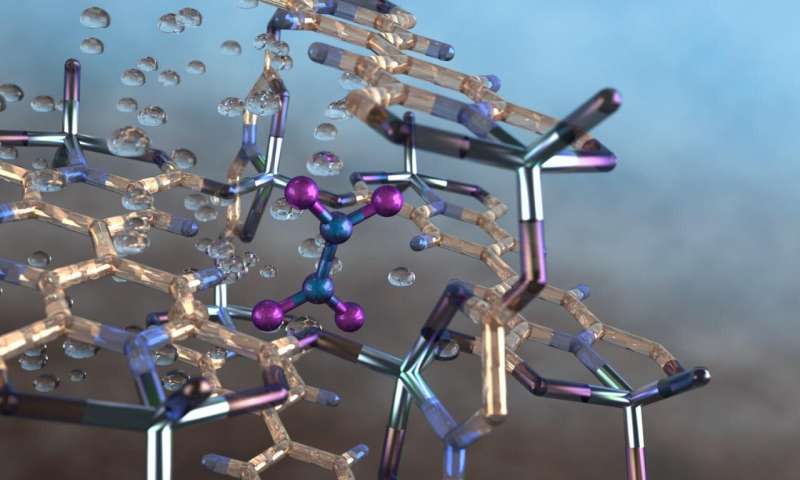
A toxic pollutant created by consuming non-renewable energy sources can be caught from the fumes gas stream and changed over into valuable modern chemicals utilizing just water and air because of another advanced material created by a global group of researchers.
New research drove by The University of Manchester, has built up a metal-natural system (MOF) material that gives a specific, completely reversible and repeatable capacity to catch nitrogen dioxide (NO2), a lethal air toxin created especially by diesel and bio-fuel use. The NO2 would then be able to be effectively changed over into nitric corrosive, a multi-billion dollar industry with utilizes including, agrarian compost for crops; rocket propellant and nylon.
MOFs are minor three-dimensional structures which are permeable and can trap gasses inside, acting like enclosures. The interior void spaces in MOFs can be huge for their size, only one gram of material can have a surface region proportionate to a football pitch.
The profoundly proficient system in this new MOF was described by analysts utilizing neutron dissipating and synchrotron X-beam diffraction at the Department of Energy’s Oak Ridge National Laboratory and Berkeley National Laboratory, separately. The group likewise utilized the National Service for Electron Paramagnetic Resonance Spectroscopy at Manchester to consider the system of adsorption of NO2 in MFM-520. The innovation could prompt air contamination control and help cure the negative effect nitrogen dioxide has on the earth.
Asin Nature Chemistry, the material, named MFM-520, can catch nitrogen dioxide at encompassing weights and temperatures—even at low fixations and during stream—within the sight of dampness, sulfur dioxide and carbon dioxide. In spite of the profoundly receptive nature of the pollutant, MFM-520 demonstrated fit for being completely recovered on different occasions by degassing or by treatment with water in air—a procedure that likewise changes over the nitrogen dioxide into nitric acid.
“This is the first MOF to both capture and convert a toxic, gaseous air pollutant into a useful industrial commodity.” said Dr. Sihai Yang, a lead creator and a senior speaker at The University of Manchester’s Department of Chemistry. “It is also interesting that the highest rate of NO2 uptake by this MOF occurs at around 45 degrees Centigrade, which is about the temperature of automobile exhausts.”
Professor and Vice-President and Dean of the Faculty of Science and Engineering at The University of Manchester Martin Schröder, a lead creator of the investigation, stated: “The global market for nitric acid in 2016 was USD $2.5 billion, so there is a lot of potential for manufacturers of this MOF technology to recoup their costs and profit from the resulting nitric acid production. Especially since the only additives required are water and air.”
As a feature of the research, the researchers utilized neutron spectroscopy and computational methods at ORNL to definitely describe how MFM-520 catches nitrogen dioxide atoms.
“This project is an excellent example of using neutron science to study the structure and activity of molecules inside porous materials,” said Timmy Ramirez-Cuesta, co-writer and facilitator for the science and catalysis activity at ORNL’s Neutron Sciences Directorate. “Thanks to the penetrating power of neutrons, we tracked how the nitrogen dioxide molecules arranged and moved inside the pores of the material, and studied the effects they had on the entire MOF structure.”
“The characterisation of the mechanism responsible for the high, rapid uptake of NO2 will inform future designs of improved materials to capture air pollutants.” said Jiangnan Li, the principal creator and a Ph.D. understudy at The University of Manchester.
Previously, catching nursery and dangerous gases from the climate was a test due to their generally low focuses and in light of the fact that water noticeable all around contends and can frequently influence adversely the partition of focused gas particles from different gases. Another issue was finding a viable method to sift through and convert caught gases into helpful, esteem included items. The MFM-520 material offers answers for a large number of these difficulties.
Disclaimer: The views, suggestions, and opinions expressed here are the sole responsibility of the experts. No Insta Daily News journalist was involved in the writing and production of this article.